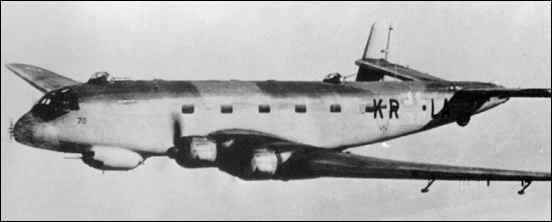Junkers Ju 290 and Ju 390
prepared by Emmanuel Gustin
A Junkers Ju-290 A5
When the Ju 290 replaced the Fw 200 as long-range reconnaissance aircraft in the autumn of 1943, the crews were given a far more capable aircraft than the old Focke-Wulf Fw 200 Condor. But only 65 Ju 290s were built, and the total number of aircraft available was never higher than about 20. It was definitely a case of too little, too late.
The Ju 290 was built by Junkers, the firm founded by Prof. Hugo Junkers, one of pioneers of all-metal aircraft construction. Junkers had a big name in the construction of giant aircraft, set with the massime G.38 airliner. However, in 1933 the new government offered him the choice between being arrested on the spot, or abandon his factories to the state and never visit them again. Henceforth Junkers was state-owned. Hugo Junkers died in 1935.
The origins of the Ju 290 went back to 1936, when the Do 19 and Ju 89 long-distance bombers were cancelled after the death of general Walther Wever. Development of long-range bombers did not stop, but was delayed until more advanced aircraft could be delivered. This decision is controversial, but with hindsight it was probably sensible. The Ju 89, designed by Dr. Ernst Zindel, would never enter production, although the two prototypes were used by the Luftwaffe in 1940.
Junkers decided to use the parts of the unfinished third Ju 89 to build a long-distance airliner, the Ju 90, with a new fuselage. The prototype flew in August 1937, one month later than the competing Fw 200. After the three prototypes, Junkers built ten Ju 90B-1 production aircraft. Eight of them were powered by BMW 132 engines, because the Jumo 211 used by the first prototype was available only for the military. Two more, ordered by South African Airways but never delivered, had American engines. The Ju 90Bs were later used as transports by the Luftwaffe. Although the Ju 90 had a modern stressed-skin structure of duralumin, it was under powered and slow. The wing was fitted with fixed trailing edge slats, characteristic of many of the older Junkers designs, but now an obsolete feature.
Hence the fourth prototype, the Ju 90V4, was used for a programme that was known as the Ju 90S (Schwer = heavy). This aircraft was given a a new wing, stronger landing gear, and more powerful engines. The new wing had a straight center section and tapered outer panels, while that of the Ju 90 tapered over its entire length. It also lacked the fixed trailing edge slats. The BMW 139 engine was considered, but after its demise the BMW 801 was adopted. In the tail the so-called Trapoklappe was fitted: A hydraulically operated loading ramp. When it was opened, the tail was lifted off the ground, and vehicles could be loaded. It could also be opened in flight, to drop supplies. The Ju 90V4 was followed by more prototypes, with a longer fuselage, defensive armament, a modified wing, and different tail surfaces.
Finally, the Ju 90V11 prototype officially became the Ju 290V1. It flew in August 1942, and production was started immediately. The two Ju 290A-0 and five Ju 290A-1 aircraft were completed as transports, and used on the Eastern front and in the Mediterranean. They had the defensive armament as tried on the Ju 90V8, that is: a gun turret above and behind the cockpit, a gondola under the left half of the nose with fore and aft guns, a tail gun, and beam guns.
The combat models
The first combat model was the Ju 290A-2. This was basically a Ju 290A-1 with FuG 200 Hohentwiel search radar. The Hohentwiel radar could detect a convoy at a distance of about 100km. The Trapoklappe was retained. The Ju 290A-3 was almost identical, but had a Focke-Wulf gun turret with a lower profile. The A-4 model had an additional dorsal gun turret, further aft. On 15 October 1943 Fernaufklaringsgruppe 5 (FAGr.5) began operations from Mont-de-Marsan, in France. They replaced the Fw 200C in its role of gatherer of information for the U-boats. After two A-2s, three A-3s, and five A-4s, it received the first A-5.
The A-5 was a fully operational combat aircraft, and appeared in the spring of 1944. It had protected fuel tanks, armour plating for the crew positions, and redesigned beam gun positions. Also, all but one of the 13mm MG131 guns were replaced by 15mm MG151 cannon, with a difference in firepower much larger than the small increase in calibre suggests. The crew was increased for seven to nine. The Ju 290A-5 was well armed, could absorb damage and did not have the structural weaknesses of the Fw 200C. This was a good replacement for the Condor, but only 11 were completed.
And three Ju 290A-5s were retracted from FAGr.5 after delivery. All their armament was removed, and additional fuel tanks installed. They made a non-stop trip to Manchuria, and a similar flight back, to exchange documents and strategic materials with the Japanese. After the loss of the Atlantic coast, the Ju 290s were all used as transports. Some went to the famous KG200, that seems to have used the bombers to drop agents and supplies behind the Allied lines.
The single A-6 was built as a personal transport for Hitler, originally with a pressure cabin but later this was abandoned and a 40-seat interior was installed. In April 1945 it flew to Spain, where it was used for some years.
Despite an order for 25 of them, Junkers completed only a few A-7s, which had an additional MG151 in a bulbous, glazed nose and was equipped to carry guided weapons. The A-8 had again increased armament, but only three or four were completed. The final version, Ju 290A-9, had reduced armament but more fuel, so that range could be increased to 8300km. The production programme was hit when the Red Army occupied the factories near Prague, but in October 1944 the programme was completely terminated: Germany could no longer afford to build the Ju 290. It needed to concentrate all resources on just a few types. The Ju 290B, C, D and E models never left the drawing board.
The Ju-390
Two prototypes flew of a radically modified derivative, the Ju 390. The idea behind this was simple: The wing center section panels, complete with engines and landing gear, where fitted twice. The fuselage was elongated. In this was the four-engine Ju 290 was modified into the six-engine Ju 390. The Ju 390V1 was equipped as as a transport aircraft, and the Ju 390V2 as a long-distance maritime patrol aircraft.
They flew in August and October of 1943. The V2 was delivered to FAGr.5, and it demonstrated its potential by flying from Mont-de-Marsan to a point 20km from New York, and back. [Editor: many believe this is a rumor and that the flight was never undertaken]
Specifications
Junkers Ju 290A-5
Nine-seat long-distance reconnaissance aircraft
Four 1700hp BMW 801D radial engines Wing span 42.00m, length 28.64m, height 6.83m, wing area 203.6m2. Maximal take-off weight 44970kg. Max. speed 440km/h at 5800m, cruising speed 360km/h. Service ceiling 6000m Range 6150km
Armament: Two dorsal turrets, each with a 15mm MG151, one MG151 in the tail, two in beam windows, and one in the front of the under nose gondola. One 13mm MG131 in the aft section of the gondola.
Specifications
Junkers Ju 390V2
Six 1970hp BMW 801E radial engines Wing span 50.32m, length 33.6m Empty weight 36900kg, max. take-off weight 53112kg Max. speed 515km/h at 6200m, cruising speed 357km/h. Max. range 9700km.
Armament: Two dorsal gun turrets, each with a MG151, and one MG 151 in the tail. Aft and front MG131s in the gondola, and two MG131 beam guns.



